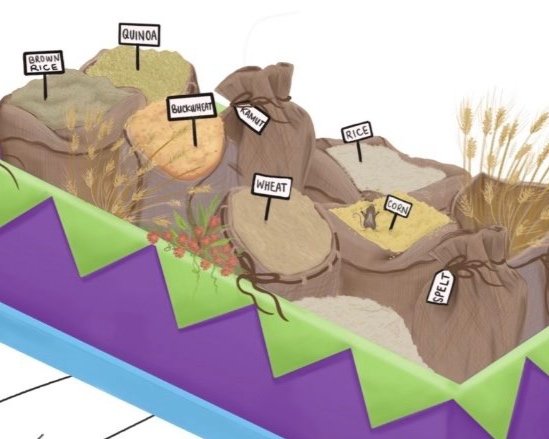What are Grains? Lesson Plan
Grains
Bread
Bran
What Are Grains?
Whole grains grow as the kernel of the plant. They provide carbohydrates for energy for our growing bodies, fiber which helps the food move through our bodies, vitamins and minerals to keep our cells and heart healthy, and protein for the growth and repair of our cells.
Whole grains have 3 parts:
Bran: fiber, vitamins and minerals
Endosperm: starch ( carbohydrate)
Germ: vitamin B, healthy fats
Refined Grains:
The bran and germ are removed by machines in the processing. The fiber, iron, vitamins and minerals are removed. Refined grains are not as good for you.
Examples of refined grains: white bread, white pasta, cookies, flour tortillas, and cereal and crackers not made from whole wheat.
Foods in the grain group include:
Wheat, oats, brown rice, barley, corn, rye, millet, farro, spelt, quinoa, bulgur, buckwheat, amaranth, and couscous
3-4 servings of whole grains is recommended for children 2-8 years old.
It’s important to eat grains every day!
Examples of one serving (1 ounce) of a whole grain for children:
1 slice of whole grain/ whole wheat bread
1/2 cup of brown or basmati rice, whole wheat pasta, couscous, barley
3/4 cup cereal ( oat, bran, rye, corn, whole grain)
1 whole grain tortilla
1/2 cup oatmeal, cream of wheat
1/2 whole grain/wheat bagel
5 whole wheat crackers
Foods that can be made with whole grains/flour:
Pizza dough
Pancakes and waffles
Chicken tenders
Muffins
Cookies
Discussion Questions:
Have you eaten a whole grain?
Do you like this food?
Why are whole grains good for you?
Hands-On Activities:
Provide bowls of dry pasta, brown rice, oatmeal...and have the students measure out a serving size for each.
Have kids glue grains on letters of their name, numbers and/or make their own masterpiece.
Let kids paint dry noodles and make sculptures with them using playdough and pipe cleaners.
Dye dry rice, let dry and use in a sensory table with scoops, measuring cups, etc.
Make macaroni necklaces with noodles and string or yarn.
Serve whole wheat crackers and cheese for a snack.




